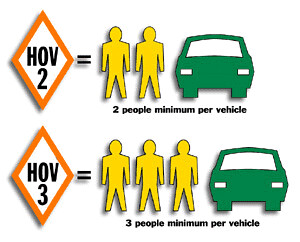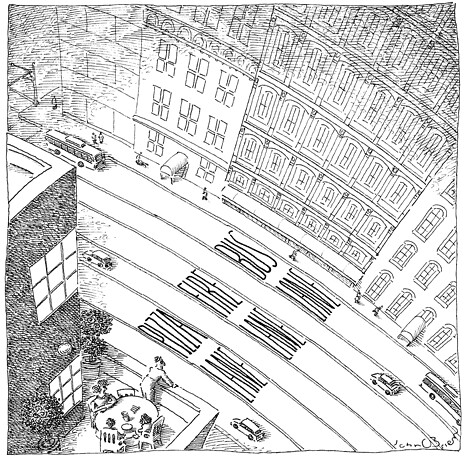Transportation demand management isn't just about cars, it's about total throughput

Image from VDOT.
Yesterday's Post has a letter to the editor ("All Opinions Are Local : How D.C. can make ride-sharing easier") excoriating DC because in the opinion of the writer, DC should be encouraging "slugging" -- a form of commuting where independent riders hook up with automobile drivers on an itinerant basis so that groups of 3 people can form and use the high occupancy vehicle lanes on I-95 and I-395 in Northern Virginia, to and from DC.
He writes:
Encouraging the use of bikes is a good idea, but one bike takes one car off the street, while discouraging convenient pickup points for slug riders makes traffic congestion worse. It’s simple math: One slug pickup puts a minimum of two extra riders in the same car, which means two fewer vehicles on the streets.
This is in response to DC's ticketing cars waiting to pick up up slugs ("'Slug drivers' being ticketed in D.C." from the Post), the negative reaction ("Va. Rep. to DC: Leave slugs alone" from the Post), and the DC Department of Transportation's belated response to the issue ("D.C seeks commuter input to help find new 'slug' pickup sites for ride-sharers"from the Post).
Slug Lines is a website about and for slugging.
Probably the most difficult problem in managing traffic and discussing transportation policy is that people are imprinted with an automobile-centric paradigm about mobility, because that has been the dominant policy over the past 50+ years, even though for the most part traditional center cities are designed to optimize walking, biking, and transit, and that overall these modes take up much less space than one car, even if the car has 3 people in it.
One 40 foot bus takes up the space of about 2.5 cars, and a 60 foot bus about 3 cars, yet the buses carry from 50 to 90 passengers in that space. If the 3 cars have either 6 people or 9 people, it's still not an optimal use of the space.
That being said, transportation policy works to balance a variety of user segments.
It's very hard for Virginians to believe, but DC's transportation policies aren't just about Virginia -- see for example Rep. Jim Moran's foolish statements about widening 14th Street NW for commuters, which would necessitate demolishing all the buildings along the street, in "Va. congressman upset at D.C.'s lack of communication" from WTOP Radio.
Instead, what the city is doing is focusing on how people get into and out of the city, how people get around within the city, plus freight movements, and by multiple modes--by car on surface streets and freeways, by railroad, by subway, by bus, by walking, and by bike.
An optimal policy just doesn't focus on people using HOV lanes in Northern Virginia, it looks at the big picture. (The same big picture motivates Arlington County, which is opposed to adding high occupancy toll lanes because overall this encourages more automobile use, not less, and is oppositional to the goals and objectives in the County's Master Transportation Plan.) Bike policies tend to be focused on intra-city transportation, although a network of regional bikeways (such as the Mount Vernon Trail, Capital Crescent Trail, Metropolitan Branch Trail, and eventually the Anacostia Riverwalk Trail) also supports longer distance commuting by bicycle within the metropolitan area
It's maybe too much to ask of Ken Kobetsky of Fairfax Station, but it's what planners have to do.
That being said, DC tends to act rashly and impulsively first, and then think about planning afterwards. The ticketing of slug drivers was no different than the city announcing with limited notice that the "Chinatown" buses had to move out of Chinatown to Banneker Overlook, a location convenient neither to riders nor to the buses and their movement patterns. This policy change went nowhere, and the status quo is pretty much in force today. (See "DCist: Intercity Bus Terminal Planned for Southwest."
A master transportation plan for DC (we don't have one) would work to balance the needs of the various mobility constituencies, including slug commuters, and have the right policies, management plans, and procedures in place to limit these kinds of problems.

Bus lane cartoon, New Yorker magazine as identified by NotionsCapital.
Labels: transportation planning



0 Comments:
Post a Comment
<< Home